
30 Results


Biology is designed for multi-semester biology courses for science majors. It is grounded on an evolutionary basis and includes exciting features that highlight careers in the biological sciences and everyday applications of the concepts at hand. To meet the needs of today’s instructors and students, some content has been strategically condensed while maintaining the overall scope and coverage of traditional texts for this course. Instructors can customize the book, adapting it to the approach that works best in their classroom. Biology also includes an innovative art program that incorporates critical thinking and clicker questions to help students understand—and apply—key concepts.
- Subject:
- Biology
- Life Science
- Material Type:
- Full Course
- Provider:
- Rice University
- Provider Set:
- OpenStax College
- Date Added:
- 08/22/2012

- Subject:
- Biology
- Life Science
- Material Type:
- Unit of Study
- Provider:
- Rice University
- Provider Set:
- OpenStax College

- Subject:
- Applied Science
- Biology
- Life Science
- Material Type:
- Module
- Date Added:
- 07/10/2017

By the end of this section, you will be able to:Understand the synthesis of macromoleculesExplain dehydration (or condensation) and hydrolysis reactions
- Subject:
- Applied Science
- Biology
- Life Science
- Material Type:
- Module
- Date Added:
- 07/10/2017

By the end of this section, you will be able to:Understand the synthesis of macromoleculesExplain dehydration (or condensation) and hydrolysis reactions
- Subject:
- Applied Science
- Biology
- Life Science
- Material Type:
- Module
- Author:
- Tina B. Jones
- Date Added:
- 08/15/2019
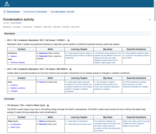
This activity models the use of the 5E instructional strategy for pacing the learning of the concept condensation. The activity can be printed or used online to support real-time formative assessment of the learners' understanding of condensation.
- Subject:
- Atmospheric Science
- Physical Science
- Material Type:
- Activity/Lab
- Author:
- Gary Sacket
- Danny Mattox
- Date Added:
- 07/28/2018

Determine the dew point temperature for your classroom through a hands-on experiment. Use humidity and temperature probes to investigate the temperature at which it would rain in your classroom! Learn about water density and the conditions necessary to produce fog or rain.
- Subject:
- Atmospheric Science
- Geoscience
- Mathematics
- Physical Science
- Physics
- Space Science
- Material Type:
- Activity/Lab
- Diagram/Illustration
- Lecture Notes
- Provider:
- Concord Consortium
- Provider Set:
- Concord Consortium Collection
- Author:
- The Concord Consortium
- Date Added:
- 12/13/2011

Join Simon, Anita and Dennis as they explore the names of clouds. And what's a Contrail?Download the Clouds Module storybook and learning activities!
- Subject:
- Atmospheric Science
- Geoscience
- Physical Science
- Material Type:
- Activity/Lab
- Reading
- Provider:
- NASA
- Provider Set:
- NASA Wavelength
- Date Added:
- 09/05/2012
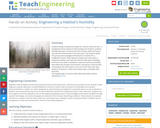
Students design a temporary habitat for a future classroom pet—a hingeback tortoise. Based on their background research, students identify what type of environment this tortoise needs and how to recreate that environment in the classroom. The students divide into groups and investigate the features of a habitat for a hingeback tortoise. These features include how many holes a temporary habitat may need, the animal’s ideal type of bedding, and how much water is needed to create the necessary humidity level within the tortoise’s environment. Each group communicates and presents this information to the rest of the class after they research, brainstorm, collect and analyze data, and design their final plan.
- Subject:
- Life Science
- Physical Science
- Material Type:
- Activity/Lab
- Provider:
- TeachEngineering
- Provider Set:
- Activities
- Author:
- Kayla Sutcliffe
- Date Added:
- 05/24/2019
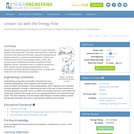
Students learn about energy and nutrient flow in various biosphere climates and environments. They learn about herbivores, carnivores, omnivores, food chains and food webs, seeing the interdependence between producers, consumers and decomposers. Students are introduced to the roles of the hydrologic (water), carbon, and nitrogen cycles in sustaining the worlds' ecosystems so living organisms survive. This lesson is part of a series of six lessons in which students use their growing understanding of various environments and the engineering design process, to design and create their own model biodome ecosystems.
- Subject:
- Applied Science
- Ecology
- Engineering
- Life Science
- Material Type:
- Activity/Lab
- Lesson Plan
- Provider:
- TeachEngineering
- Provider Set:
- TeachEngineering
- Author:
- Christopher Valenti
- Denise Carlson
- Malinda Schaefer Zarske
- Date Added:
- 09/18/2014

In this problem-based learning (PBL) activity, students take on the role of a student research scientist and explore the role of solar energy in determining climate. Students conduct experiments to observe how a change in water phase affects surface temperatures. Materials required for the investigation include 2 aquariums, dry sand or soil, two heat lamps, and two thermometers.The lesson is supported by teacher notes, answer key, glossary and an appendix with information about using PBL in the classroom. This is the second of three activities in Investigating the Climate System: Energy, a Balancing Act.
- Subject:
- Atmospheric Science
- Geoscience
- Mathematics
- Physical Science
- Material Type:
- Activity/Lab
- Lesson Plan
- Provider:
- NASA
- Provider Set:
- NASA Wavelength
- Date Added:
- 11/05/2014
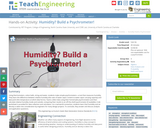
Using thermometers, cotton balls, string and water, students make simple psychrometers—a tool that measures humidity. They learn the difference between relative humidity (the ratio of water vapor content to water vapor carrying capacity) and dew point (the temperature at which dew forms). Teams collect data using their homemade psychrometers and then calculate relative humidity inside and outside, comparing their results to an off-the-shelf psychrometer (if available). A lab worksheet is provided for data collection and calculation. As a real-world connection, students learn that humidity and air density is taken into consideration by engineers for many design projects. To conclude, they answer and discuss analysis and application questions.
- Subject:
- Algebra
- Mathematics
- Physical Science
- Statistics and Probability
- Material Type:
- Activity/Lab
- Provider:
- TeachEngineering
- Provider Set:
- Activities
- Author:
- Ashley Martin
- Dale Gaddis
- Hannah Brooks
- Lazar Trifunovic
- Michael A. Soltys
- Shay Marceau
- Date Added:
- 11/29/2017
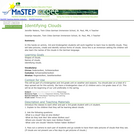
Hands-on group activity in where children go outside to find clouds, document with pictures, and identify them.
- Subject:
- Atmospheric Science
- Geoscience
- Physical Science
- Material Type:
- Activity/Lab
- Lesson Plan
- Provider:
- Science Education Resource Center (SERC) at Carleton College
- Provider Set:
- Pedagogy in Action
- Author:
- Jodi Erickson
- Date Added:
- 10/04/2011
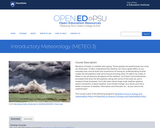
Benjamin Franklin is credited with saying, “Some people are weatherwise, but most are otherwise.” Ol’ Ben understood that weather can have a great effect on our everyday lives, and he knew the importance of having an understanding of what makes the atmosphere work (and not just knowing when it’s safe to fly a kite). In Meteo 3, we will examine all aspects of the weather. You’ll learn the fundamental processes that drive the atmosphere, along with some of the tools we use to measure those processes. You’ll also learn about large-scale weather systems, severe convection, tropical weather, and climate change. As a result, you’ll be a better consumer of weather information and forecasts. So… do you want to be weatherwise?
- Subject:
- Atmospheric Science
- Physical Science
- Material Type:
- Full Course
- Provider:
- Penn State College of Earth and Mineral Sciences
- Author:
- Steve Seman
- Date Added:
- 10/07/2019
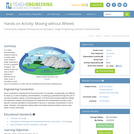
In a class demonstration, students observe a simple water cycle model to better understand its role in pollutant transport. This activity shows one way in which pollution is affected by the water cycle; it simulates a point source of pollution in a lake and the resulting environmental consequences.
- Subject:
- Applied Science
- Engineering
- Hydrology
- Physical Science
- Material Type:
- Activity/Lab
- Provider:
- TeachEngineering
- Provider Set:
- TeachEngineering
- Author:
- Alejandro Reiman-Moreno
- Amy Kolenbrander
- Denise Carlson
- Janet Yowell
- Malinda Schaefer Zarske
- Natalie Mach
- Tyman Stephens
- Date Added:
- 10/14/2015
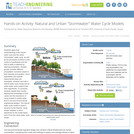
Students apply their understanding of the natural water cycle and the urban "stormwater" water cycle, as well as the processes involved in both cycles to hypothesize how the flow of water is affected by altering precipitation. Student groups consider different precipitation scenarios based on both intensity and duration. Once hypotheses and specific experimental steps are developed, students use both a natural water cycle model and an urban water cycle model to test their hypotheses. To conclude, students explain their results, tapping their knowledge of both cycles and the importance of using models to predict water flow in civil and environmental engineering designs. The natural water cycle model is made in advance by the teacher, using simple supplies; a minor adjustment to the model easily turns it into the urban water cycle model.
- Subject:
- Applied Science
- Engineering
- Hydrology
- Physical Science
- Material Type:
- Activity/Lab
- Provider:
- TeachEngineering
- Provider Set:
- TeachEngineering
- Author:
- Andrew O'Brien
- Austin Childress
- Carleigh Samson
- Maya Trotz
- Ryan Locicero
- Date Added:
- 09/18/2014

Through an overview of the components of the hydrologic cycle and the important roles they play in the design of engineered systems, students' awareness of the world's limited fresh water resources is heightened. The hydrologic cycle affects everyone and is the single most critical component to life on Earth. Students examine in detail the water cycle components and phase transitions, and then learn how water moves through the human-made urban environment. This urban "stormwater" water cycle is influenced by the pervasive existence of impervious surfaces that limit the amount of infiltration, resulting in high levels of stormwater runoff, limited groundwater replenishment and reduced groundwater flow. Students show their understanding of the process by writing a description of the path of a water droplet through the urban water cycle, from the droplet's point of view. The lesson lays the groundwork for rest of the unit, so students can begin to think about what they might do to modify the urban "stormwater" water cycle so that it functions more like the natural water cycle. A PowerPoint® presentation and handout are provided.
- Subject:
- Applied Science
- Engineering
- Hydrology
- Physical Science
- Material Type:
- Lesson Plan
- Provider:
- TeachEngineering
- Provider Set:
- TeachEngineering
- Author:
- Brigith Soto
- Jennifer Butler
- Krysta Porteus
- Maya Trotz
- Ryan Locicero
- William Zeman
- Date Added:
- 09/18/2014
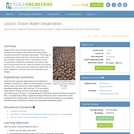
Students learn about the techniques engineers have developed for changing ocean water into drinking water, including thermal and membrane desalination. They begin by reviewing the components of the natural water cycle. They see how filters, evaporation and/or condensation can be components of engineering desalination processes. They learn how processes can be viewed as systems, with unique objects, inputs, components and outputs, and sketch their own system diagrams to describe their own desalination plant designs.
- Subject:
- Applied Science
- Engineering
- Hydrology
- Physical Science
- Material Type:
- Lesson Plan
- Provider:
- TeachEngineering
- Provider Set:
- TeachEngineering
- Author:
- Carleigh Samson
- Denise W. Carlson
- Juan Ramirez Jr.
- Stephanie Rivale
- Date Added:
- 09/18/2014
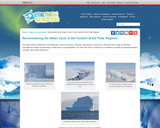
This article explains how the ice and snow of the polar regions fit in the global water cycle and includes links to professional development resources.
- Subject:
- Applied Science
- Environmental Science
- Geoscience
- History
- History, Law, Politics
- Physical Science
- Material Type:
- Reading
- Provider:
- Ohio State University College of Education and Human Ecology
- Provider Set:
- Beyond Penguins and Polar Bears: An Online Magazine for K-5 Teachers
- Author:
- Jessica Fries-Gaither
- Date Added:
- 10/17/2014